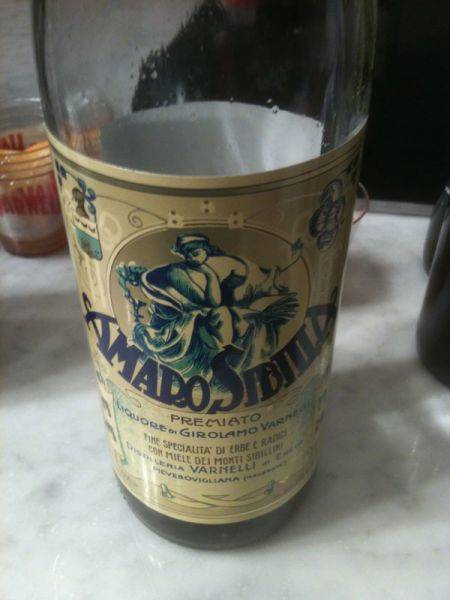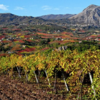The Natural Wines of Domodimonti
Often, when I hear of a new winery or one that has just renovated its facility, I become a bit suspect. In most cases these wineries are going to make wines that are international in style and not to my taste.
So when I was invited to taste the wines of Domodimonti at Eataly I noted that the winery was started in 2003 and built a new facility in 2010. Was I going to be wasting my time tasting wine that I did not like and could not write about? Curiosity got the better on me and I accepted the invitation. As it turned out, I was very glad that I did.
Not only did I like the wines but found the tasting interesting and informative.
The speaker was Niccolo Salvadori, the general manager of the Eataly wine store. He said that the winery was located at Montefiore dell’Aso in the Marche. Marco Scapagnini, sales and marketing manger from the winery, assisted him.
Mr. Scapagnini began by saying that they were not a certified organic winery but a “natural” wineey. What makes it “natural” is that the grapes are sustainable-grown using organic matter, low–yielding vineyards and the grapes are hand picked. No sugar is added to the wine. There is a strict selection of yeast and there are no additives made for color, acidity, mouth-feel, etc. The addition of sulfites is kept to a minimum and they use of state-of-the-art technology.
The new winery built in 2010 was designed to generate the least amount of visual and ecological impact on the land. He added that they exceed the rules and regulations of organic farming.
Mr. Salvadori led us in a tasting of the wines:
Offida Passerina “Déja” DOC 2010 100% Passerina
The vineyards are at 200 meters and have a southern exposure. There are 3,000 vines per hectare. The training system is cordon with spur pruning. 80% of the grapes are picked at the beginning of September and 20% are picked a little later.
The wine is fermented and aged in temperature-controlled vats with an external insulation jackets. It undergoes malolatic fermentation and remains on the lees for a period of time. This white wine was grassy and fruity at the same time. Malolatic fermentation and the late harvesting of a percentage of the grapes and the nature of the Passerina grape added roundness and a slight sweetness to the wine. There were hints of baked apples and pears. It had a nice finish and pleasing aftertaste. It went very well with the first course, a fish crudo seasoned with sea salt and olive oil. $13
In answer to a question about sulfites in their wines Mr. Scapagnini responded that their entire wine making process is performed under nitrogen and they use cryomaceration, a process with very low temperatures, 2-5 degrees C to ensure protection against oxidation.
Offida Pecorino “Li Coste” DOC 2009 100% Pecorino
The vineyards are at 200 meters. They have a southern exposure and there are 4000 vines per hectare. The training system is Guyot and the harvest takes place in early September. The wine is fermented in stainless steel. It is aged in barriques made from acacia wood. Mr. Salvadori mentioned that he only knew of one other winemaker that used acacia barriques and he produces a Gavi. Mr. Scapagnini said that they only use new barriques because acacia wood barriques can only be used once. Only 10% of the wine is aged for two to three months in this way. The other 90% is aged in stainless steel vats. It had nice citrus aromas and flavors with hints of white peaches, orange peel, hazelnuts and a touch of pepper. $16
Marche Sangiovese “ Monte Fiore” IGT 2010 100% Sangiovese. The vineyards are at 200 meters with a southern exposure. They use Cordon training with spur pruning. The soil is mainly clay. There are 3,000 vines per hectare and the harvest takes place in the beginning of September. The wine is aged in stainless steel. This is a very easy wine to drink, with ripe red fruit aromas and flavors and hints of strawberries and red plums. $13
Marche Rosso “Picens” IGT 2006. The wine is made from 25% Montepulciano, 25% Sangiovese 25% Merlot and 25% Cabernet Sauvignon. The vineyards are at 250 meters and the soil in mainly clay. The vineyards are south facing, there are 4,000 vines per hectare and the training system is Condon with spur pruning. The harvest is from the end of September to the middle of October. The wine is aged in second passage French barriques for 5 to 6 months.
There were flavors and aromas of dark fruit with hints of blackberries and a touch of leather. $16
Marche Rosso “IL Messia” IGT 2007 60% Montepulicano and 40% Merlot. The vineyards are at 250 meters and the soil is mostly clay. These vineyards have a southern exposure, there are 4,000 vines per hectare and the harvest takes place in the end of September and the beginning of October. The Montepulicano is aged in French barriques, which are 3 years old. The Merlot is aged in special troncoconic vats. This type of vat is tapered on the top and smaller in size than the bottom. It allows for the increase in contact between the juice and the skins during fermentation and maceration, which results in the extraction of softer and sweeter tannins.
This was the most modern in style of the wines that we tasted but it was well balanced. It is a full-bodied wine with deep black fruity aromas and flavors with hints of blackberry, vanilla and oak. $35
I should have remembered an old saying that I often use, “do not judge a winery until you taste their wines!” I enjoyed tasting the wines very much and look forward to drinking them. In addition, the wines were priced very well.
After the wine tasting there was a presentation by the Varnelli Company from the Marche of their amari and other spirits. Varnelli is a family run business (run by four women) and Orietta Maria Varnelli, C.E.O. and export manger was the speaker and told us about their line of spirits. She said they were most famous for their L’ Anice Secco Speciale.
We tasted the Amaro Sibilla on the rocks with Lurisia Gazzosa, a fizzy lemon drink made from Amalfi lemons and a slice of orange. It has aromas of bitter herbs and dried fruit with hints of coffee and honey. On the palate it is bitter and tannic with touches of chestnut, honey and coffee. It is a perfect amaro to have after a meal. I like it neat! The ingredients are of course a family secret.









































i-Italy
Facebook
Google+
This work may not be reproduced, in whole or in part, without prior written permission.
Questo lavoro non può essere riprodotto, in tutto o in parte, senza permesso scritto.